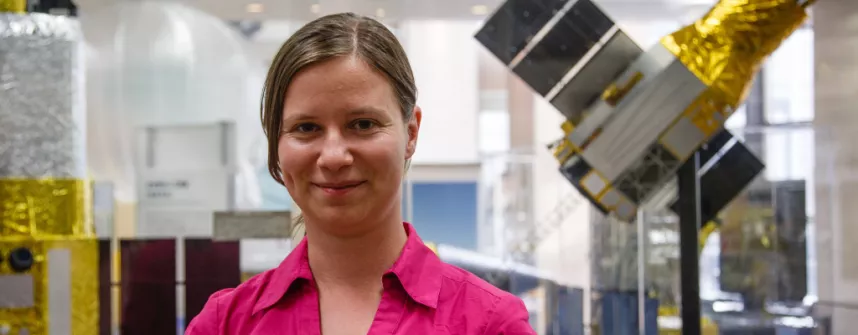A star in the heavens of astrophysics
(Source: Constructor University)
What’s going on up there is hard to understand, even for her. The universe is too big, too abstract, too complex; it bursts the bounds of our imagination, which is marked by our experience on our little earth. “Everyone knows how long a centimeter is. But what distance do a thousand light years measure?”, asks astrophysicist Aurora Simionescu. “The exciting thing about astrophysics is that I don’t understand it. I try to expand the limits of my knowledge; every day a little more. That is the challenge.” Studying at Jacobs University in Bremen has aroused her curiosity.
As the first non-Japanese, the 33-year-old was recently appointed Associate Professor by the Japanese Aerospace Exploration Agency. She got her doctorate with honors at the Ludwig Maximilian University in Munich and did research at Stanford University in the USA, as an Einstein Postdoctoral Fellow. In 2015, the British magazine Financial Times included her in its list of the 100 most important “challenger personalities” from Central and Eastern Europe, who are shaping the future. The Romanian, it is safe to say, is still a young, but already very brightly shining star in the sky of astrophysicists.
That has a lot to do with two things. For one, with a book by an American scientist on astronomy and the structure of the universe, which she read as a teenager and which aroused her interest in researching heavenly phenomena. For another, with the degree she completed in 2005 at the then International University Bremen, which is now Jacobs University in Bremen-North. “Without the enthusiasm, encouragement, and support of my professors, I would probably have followed a different path,” says Aurora Simionescu today.
“One of the best experiences of my life,” she calls her course of study in Bremen. And not just because of her professors, but also because of her fellow students. “Having lived on an international campus together with students from all over Europe, America, Africa, and Asia was an invaluable experience.” No wonder then that she flew from Japan to Bremen for the tenth year homecoming of her class, in order to meet old friends. On her travels around the globe, too, she often shares a beer in the evening with alumni who are scattered all over the world. “This cohesiveness, this network is a
lifelong gift.”
She also views the universe as a kind of gift of unbelievable beauty. And her gaze is aimed not at individual stars but at galaxies. Each individual one consists of an uncounted number of stars; in our galaxy, the Milky Way, there are probably about 100 billion. The universe is full of galaxies. Some, like
the Milky Way, more or less keep to themselves; others shoulder together to form a cosmic network. She is researching this network, trying to comprehend it, and to find changes. Because the universe is growing. How exactly this change proceeds, no one knows.
Her view of the infinite reaches of space is made possible by X-ray telescopes that circle the earth. Aurora Simionescu analyses their images and decides where to point the telescopes to get additional information. “When a stranger asks me what I do, and I don’t feel like giving any long explanations, I sometimes say I’m a data analyst. That really explains it quite well.”
And explaining is one of her many strengths. You can convince yourself of that in her blog at http://earthinpink.com/. Under the heading “Astronomy for Everyone,” she provides a vivid introduction to the world of astrophysics and her work, mostly free of purely theoretical scientific jargon. You can see many fascinating photos, from space, but also pictures she took herself here on earth – because photography is one of her hobbies. “I wanted to bring the beauties of the cosmos together with our little planet on one page.”
She also uses the blog, the media attention of being included in the Top 100 Challengers list, and her award as Person of the Year 2008 by a Romanian daily newspaper to get others excited about astrophysics. In particular, she wants to motivate young women in Romania to take their own path – even outside traditional career choices. “Being able to help others find and pursue their passion is a great motivation for me.”
Aurora Simionescu is currently expanding her own research group, with her own doctoral candidates and post-docs. And she is participating in a large project, the construction of a new Japanese space telescope as a replacement for the “Hitomi” satellite, which was lost in space a little less than a year
ago. So there’s a lot to do, but, if at all possible, she will board a flight in Tokyo this coming summer that will take her to Bremen: to the next Alumni Meeting at Jacobs University.
